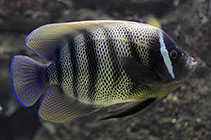| Family: |
Pomacanthidae (Angelfishes) |
| Max. size: |
46 cm TL (male/unsexed) |
| Environment: |
reef-associated; marine; depth range 3 - 60 m, non-migratory |
| Distribution: |
Indo-Pacific: Ryukyu Islands to Malaysia and Indonesia to Solomon Islands, south to Australia. |
| Diagnosis: |
Dorsal spines (total): 13-14; Dorsal soft rays (total): 18-23; Anal spines: 3-3; Anal soft rays: 18-19. Description: Adults yellowish tan with 5 black bars on the sides; scales with blue spots in the middle; head blackish with a white bar behind the eye, running from below the origin of the dorsal fin to the lower edge of the operculum; the caudal and the posterior portions of the dorsal and anal fins with blue spots. Juveniles blackish with about 15 curved narrow blue and white bars on the sides (Ref. 2334). Body depth 1.7-1.9 in SL. Scales longitudinal series 47-50 (Ref. 90102). |
| Biology: |
Juveniles prefer sheltered inner reefs while adults occur in areas of rich coral growth and high vertical relief of lagoon and seaward reefs. Adults semi-silty coastal to about 50 m depth, often seen in pairs (Ref. 48636). Occur solitary or mostly in pairs, are very elusive. Emits loud grunting sounds when harassed. Only the young make excellent aquarium fish (Ref. 4859). |
| IUCN Red List Status: |
Least Concern (LC); Date assessed: 08 October 2009 Ref. (130435)
|
| Threat to humans: |
harmless |
Source and more info: www.fishbase.org. For personal, classroom, and other internal use only. Not for publication.

